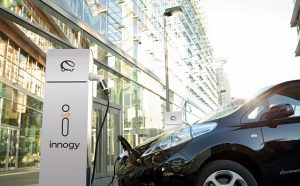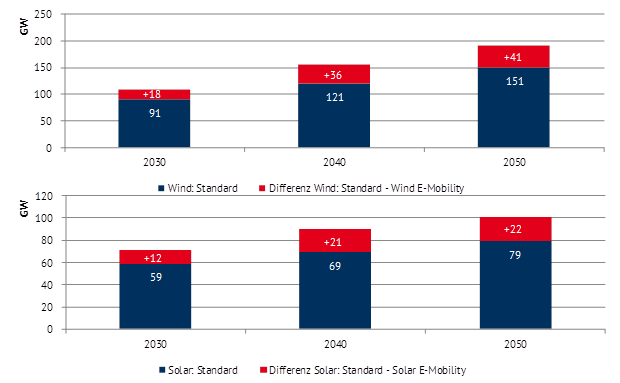The switch towards E-mobility in Germany allows for an additional PV and wind capacity addition of 63 GW, as well as an emission reduction in the private transport sector and the power generation by 70 percent.

The future development of E-mobility is a decisive factor for European and German targets for reducing greenhouse gas emissions. Amongst others the resolution of the Federal cabinet formulated a complete decarbonization of the mobility sector until the year 2050.
Switching from internal combustion engines to electric motors entails a strong increase in electricity demand, due to coupling the mobility and the power sector. Figure 1 depicts the additional electricity demand in the EU28 countries in Terawatthours for the year 2050. This additional demand is generated by the introduction of large-scale E-mobility, i.e. a completely decarbonated private transport sector (100 percent electric cars).

Figure 1: Growth of electricity demand by switching from internal combustion engines to E-mobility in the private transport sector (source: Energy Brainpool)
For Germany, such an increase in electricity demand from currently roughly 600 TWh to 725 TWh in 2050 corresponds to a growth of more than 20 percent. The energy concept of the Federal Government however envisions a reduction of the gross electricity consumption by 25 percent by 2050. Increased electricity demand by E-mobility however also reduces the consumption of fuels in inefficient combustion engines and could therefore be synergistic with the government’s goal of reducing the primary energy consumption of Germany.
In order to avoid emission spills from the transport sector to the power sector – by generating the required additional demand for electricity by fossil power plants – it is pivotal to build-up additional solar and wind power capacities.
This analysis shows that a system with 100 percent E-mobility in the private transport sector allows the expansion of solar and wind capacities in Germany by a total of up to 63 GW by 2050 (see figure 2).

Figure 2: Expansion for wind (top) and solar (bottom) in Germany when comparing different scenarios. The results are based on the „Standard“ and on the „E-mobility“ scenarios of the Energy Brainreport 2017 (source: Energy Brainpool)
Currently, Germany’s installed capacity for PV amounts to about 41 GW, the one of wind power to 50 GW. As can be inferred from figure 2, the expansion of both technologies has to accelerate dramatically in order to cover the additional electricity demand from electric cars and to achieve Germany’s energy and climate goals. For PV this would translate into a 2.5-fold capacity increase to 100 GW in 2050. The capacity for wind energy would almost have to quadruple to 190 GW by 2050. The current expansion targets and plans for renewable energies fall short of those numbers by some margins.
Due to the Merit-Order effect of the fluctuating renewable energies (fRE) solar and wind, those exert downward pressure on electricity prices. In view of the additional expansion of fRE in the “E-mobility” scenario a significant influence on prices could be expected. However, the analysis of the Energy Brainreport 2017 shows that only marginal deviations in power prices occur between the different scenarios. Nevertheless, the volatility of power prices increases due to a higher share of fRE.
Regarding the emissions, sector coupling in terms of private transport and power dramatically reduces greenhouse gas emissions – provided that a the expansion of fRE is intensified. CO2-emissions in the private transport sector and the power sector could mutually be curbed by 70 percent compared to 2015. The standard scenario only allows for an emission reduction of about 40 percent.
This article is based on the latest Energy Brainreport 2017, which contains the complete analysis.



